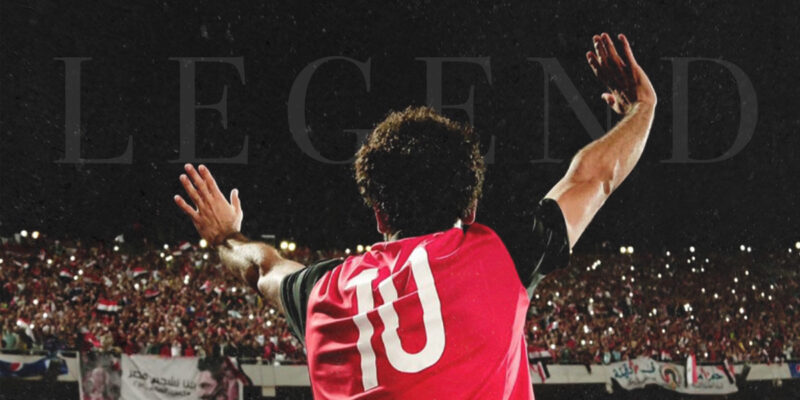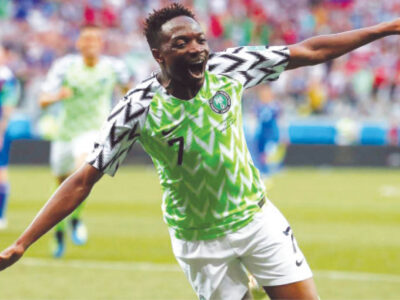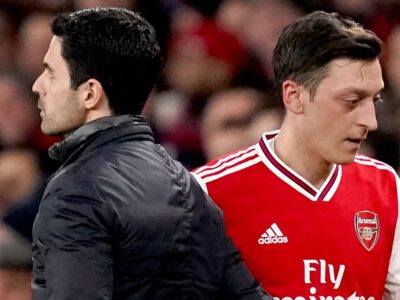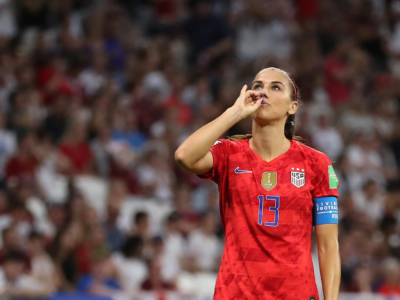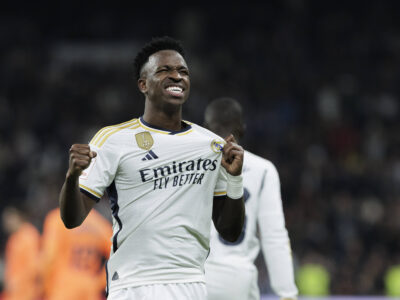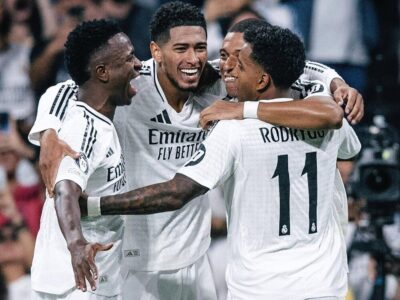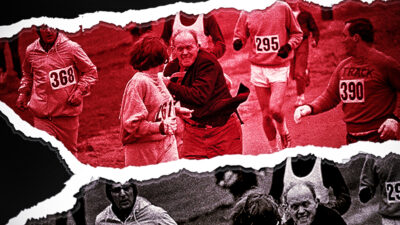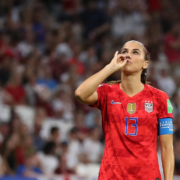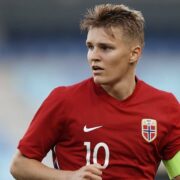Liverpool has just returned to their perch alongside Manchester United. But all the attention for this monumental achievement goes to Mohamed Salah.
Even though the Ballon d’Or shouts have now evaporated into the ether, Mohamed Salah has been the focal point in Liverpool’s attack over the past few years, scoring goals and creating chances.
At some point, he even came close to comparisons with Lionel Messi and Cristiano Ronaldo.
But before the Egyptian talisman became the Mo Salah we know and adore today, he went through a tumultuous journey that started from the land of the pharaohs to Merseyside.
Today, he is one of the best players to put on a Liverpool shirt and a certified legend of Egyptian football.
This is how the Mo Salah story began.
Early Life and Career Beginnings
Mohamed Salah was born on June 15, 1992, in a quiet village in Egypt’s Gharbia Governorate called Nagrig.
Like many kids in rural Egypt, Salah grew up kicking balls in the heat along dusty and unpaved streets.
Watching him in those early days, you just knew he wasn’t like the others. His talent needed more than village pitches.
It is not surprising that some of his idols while growing up were Ronaldo Nazario and Zinedine Zidane.
Salah’s formal journey began at El Ittihad Basyoun and then at Othmason Tanta, two modest youth clubs in Egypt, where he galvanized his quick feet and relentless work ethic.
His journey from his home to the training facilities in Cairo was long and strenuous, taking up to three hours each way, five days a week. This often meant he could only spend about two hours a day in school. It wasn’t glamour; it was grit.
But Salah, with his unwavering determination, refused to back down. Step by step, he transformed raw talent into a career just waiting to explode.
In 2006, Salah made the crucial move to Al Mokawloon, a top-flight Egyptian club based in Cairo, after impressing scouts with his explosive pace and remarkable discipline.
It wasn’t an instant success. Initially, he played as a left-back in the youth team, but later transitioned to a forward position.
At 15, the first-team manager of Al Mokawloon, Mohamed Radwan, noticed his talent and promoted him to the senior squad.
However, he struggled physically against seasoned professionals and often sat on the bench, visibly frustrated.
Salah bided his time, becoming one of the best players in Egypt and catching the eye of scouts from Europe.
Moving to Europe
Mohamed Salah’s leap to Europe wasn’t smooth, and honestly, few fans today realize how close he came to being stuck.
After lighting up the Egyptian Premier League, Salah caught the attention of FC Basel.
Yet, when Basel came calling in 2012, the Egyptian Football Association initially blocked the move, citing “national service” obligations—a vague excuse that smelled more of bureaucracy than patriotism.
The timing of Salah’s move to Europe couldn’t have been more chaotic. Egypt was still fresh from the Arab Spring—a time of both hope and uncertainty, mirroring the unpredictability of Salah’s career at that point.
As Essam El-Hadary later reflected, the country was rebuilding itself, and young talents like Salah were symbols of a new Egypt eager to be seen.
Also, the Port Said riot, as well as the subsequent suspension of the Egyptian Championship, threw another spoke in the wheel of the transfer engine. Salah’s dream move hung by a bureaucratic thread.
It was the kind of frustrating obstacle that reminds me of Mohamed Zidan’s nightmare when he had to beg officials to gain control of his own future.
Clubs like Al Mokawloon are feeder clubs for the big dogs, Zamalek and Al Ahly. So that was meant to be the natural pathway for a rising star like Salah.
Sensing the hopelessness of being stuck in this Mediterranean quicksand, Salah went public with his frustration, pleading with the federation to release him on live television.
In 2012, Mohamed Salah had to beg on TV with an Al Mokawloon official to get a move to FC Basel. A reminder of why so few Egyptian players make it to Europe: even when they want to, it’s almost impossible.
byu/Amu_1310 insoccer
He cajoled the officials to negotiate with the Basel representatives, emphasizing the importance of the deal for his career prospects.
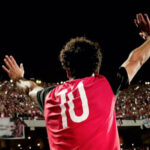
“I want to make my country proud in Europe.”
Parallels can be drawn with the manner in which Dynamo Kyiv’s president, Ihor Surkis, stopped players like Andriy Yarmolenko from exiting the Ukrainian League until late in their careers.
Salah at Basel
Mohamed Salah finally secured his move, signing with Basel after his squabble with the Egyptian FA.
At Basel, Salah made his debut in a friendly against Steaua Bucharest and scored twice, despite only coming on at halftime.
He was quick on the break and intuitive with his decisions, blending blistering pace with smart movement.
He played a crucial role in the club’s domestic success, winning the Swiss Super League twice.
Despite his exploits domestically, Salah’s performances echoed louder in European competitions.
Some unforgettable moments came in the UEFA Champions League group stages against Chelsea.
In 2013, he scored against Chelsea at Stamford Bridge in a 2–1 win, after scoring in the reverse fixture earlier.
A few months before the Champions League matchup, Salah faced Tottenham in the Europa League quarter-finals. He helped Basel edge out Spurs on penalties.
The next round set up another thrilling encounter with Chelsea. Although he scored in the second leg of the semi-finals, his goal was not enough to see his team to the finals.
Salah’s performance was so eye-catching that it put him on the radar of top European clubs.
Fans around the world knew him now, and a move to a bigger club was imminent.
Mo Salah at Chelsea
When Chelsea signed him in 2014, many believed it was the climax of his story. But reality hit hard.
Jose Mourinho signed him, off the back of his performance against the Blues a few months earlier, and Chelsea fans were looking forward to the Egyptian lighting up the Bridge.
But almost immediately, Salah found himself stuck in a system that didn’t suit him and a pecking order he couldn’t shake.
In his first few months, he showed flashes of his technical brilliance and blistering pace. He scored against Arsenal in the infamous 6–0 win, Wenger’s 1,000th game in charge.
But beyond that, Salah struggled for minutes. The Premier League’s rough pace tested his resilience, and he struggled to make tangible input in games with the meager minutes given.
Mourinho publicly praised his work rate but privately questioned his physicality and decision-making.
There was one press moment where Mourinho, asked about Salah’s lack of game time, quipped that the Egyptian needed to “learn the tactical game.” That statement told fans everything; Salah wasn’t trusted.
There were whispers of frustration. During training sessions, Salah often performed better than some starters, yet remained benched.
In one reported touchline moment, he seemed visibly agitated after being substituted prematurely, though he kept his composure publicly.
He had the talent, no doubt about that, but the conditions weren’t favourable for him to blossom.
At this point, talks of playing time elsewhere surfaced. Salah, needing game time to garner top-level experience, seized the opportunity and left the club.
The Slow Climb Back
When Chelsea loaned Mohamed Salah to Fiorentina in 2015, most casual fans wrote him off as one of the soon-to-be-forgotten victims of Chelsea’s loan factory.
But some of us who remembered the kid terrorizing Tottenham in FC Basel’s Champions League win knew better.
In Florence, Salah found a platform to prove that he was not the Chelsea reject many thought him to be, but a player with immense potential and determination.
One unforgettable night at the San Siro, he scored twice against Inter Milan—a performance so dazzling that Italian papers compared him to legends who wore la viola before him.
Still, Fiorentina couldn’t keep him. Salah opted for Roma, a move many misunderstood at the time. It wasn’t about money; it was about trust.
Under the tutelage of Luciano Spalletti, Salah developed into a complete forward. He was not just a speed merchant anymore; he became a seasoned attacker with remarkable efficiency, racking up double figures in goals and assists.
Quietly, he tormented Europe again. In the Champions League, he helped Roma survive brutal group stages, often being the difference between hope and humiliation.
One of his standout performances during his stint at Roma was against Fiorentina. Not taking any prisoners, Salah absolutely tore Fiorentina apart, scoring two goals and providing one assist.

“I was at Roma for two years, had two great seasons there, and everyone told me to stay, but it was in my mind to come and be successful in England.“
His time in Italy was a huge success, and he couldn’t have dreamt of a better place to rejuvenate his career. His success at Roma was a satisfying chapter in his career, both for him and his fans.
He was performing at the level many expected him to be when he signed for Chelsea.
At this point, it was a question of “where would he conquer next?”.
After two full seasons in Italy, it was time to leave for a new quest.
Mo Salah Joins Liverpool
When Liverpool announced Mohamed Salah’s signing in 2017, a lot of Premier League fans, especially Liverpool fans, rolled their eyes and vehemently questioned the move.
Another Chelsea reject? It felt, at first glance, like recycling—the same skepticism that followed Romelu Lukaku and Kevin De Bruyne, who became world-class players after leaving Chelsea.
Then the games started, and everything changed. It quickly dawned on everyone that Liverpool had acquired a very different Salah from the one who featured for Chelsea.
Mo Salah settled perfectly into the team. He didn’t just fit into Klopp’s high-octane football; he became its frontman.
His debut season was record-breaking: 32 goals in the Premier League, smashing the previous 38-game record.
In spite of this brilliance, a lot of fans were still in doubt of his ability, tagging him a “one-season wonder” and expecting a decline in his performance. Some even whispered that Salah would be another Michu—flashy for one season, completely forgotten in the next..
The brilliance lasted for more seasons—we’re now deep into the 8th year of Mohamed Salah’s reign of terror in the Premier League.
Salah. One season wonder and I called it last season.
— Scousericey (@scousericey) September 20, 2018
You don't get a world class footballer going under the radar until he's 25. Ask Messi and Ronaldo.
He went on to prove the doubters wrong with top-notch displays domestically and in European competitions.
Salah won numerous individual awards and team trophies, a well-deserved reward for his outstanding displays during his time at Liverpool.
What people often forget is how Salah carried Liverpool through critical Champions League nights.
Against Manchester City in the quarterfinals, his early goal at Anfield broke City’s spirit. In Rome, against his former club, the Romanisti gave him a standing ovation.
In the final against EPL rivals Tottenham, Salah opened the scoring with a calm penalty in the second minute. His early goal paved the way for a 2-0 victory, securing his first Champions League title.
No longer the boy wondering if Europe would embrace him, he became the Pharaoh, and the Kop roared his coronation.
The Terrific Trio
Mohamed Salah’s brilliance at Liverpool was undeniable, but his partnership with Sadio Mane and Roberto Firmino elevated it to something historic.
Together, they spearheaded the attacking unit, and they knew exactly when to pounce. Their chemistry felt almost telepathic—Firmino dropping deep, Salah and Mane slicing into half-spaces with terrifying speed.
Every press, every pass, every counterattack appeared choreographed yet impulsive, as if they knew where each other would be at every given moment.
Their intensity was the beating heart of Klopp’s famed gegenpressing ideology. When they pressed, it was precise and relentless.
Their dominance showed up on the biggest stages. Two consecutive Champions League finals—heartbreak against Real Madrid in 2018, redemption against Tottenham in 2019—cemented their status as one of Europe’s all-time prolific trios.
In the league, their duels with Manchester City became a modern dramatic saga unfolding again and again.
Liverpool’s 97-point season in 2018-19, finishing just one point shy of City, would’ve won the title in any normal year.
However, they came back even stronger the following year to win the Premier League the following season, ending a 30-year drought.
Yes, this was the “COVID Cup”, but they all count the same.
When fans look back on the trio’s time together, they realize how special and rare it was to see three individuals gel together to function optimally.
They were selfless when it mattered, driven by collective hunger, not personal stats. Their time together was a once-in-a-generation fusion of speed and skill.
Playing Style and Strengths
Watching Mohamed Salah play is like seeing a master craftsman at work, but at sprint speed. His technical skills are excellent—the way he shifts the ball between feet, the tight close control even when he’s sprinting at full throttle, feels almost unfair.
Salah’s pace isn’t just about raw speed; it’s his acceleration from standing still, that explosive first step, that leaves defenders confused and in disarray.
What truly sets him apart is his prolific goal-scoring ability. When Liverpool signed him, few could have predicted he would become one of the most prolific scorers in Premier League history.
Nonetheless, he became “that player”. Season after season, Salah racks up numbers that would be career highs for most, and he does it with outstanding efficiency.
He scores from everywhere — left foot, right foot, poacher’s tap-ins, set-pieces, and curling rockets from outside the box. It’s not just the volume; it’s the consistency.
Mo Salah in the PL since he joined Liverpool:
— StatMuse FC (@statmusefc) March 25, 2024
1st in G/A
1st in goals
1st in shots on target
1st in opp box touches
2nd in assists
2nd in big chances created
He has 219 league G/A in that span, 50 more than the next player. pic.twitter.com/ZMZKEotyfY
Tactically, Salah is a coach’s dream. He reads the game two steps ahead, knowing when to stretch defenses wide and when to cut inside to overload the middle of the pitch.
He has played across the front line, even dropping deeper when Klopp’s system demanded more flexibility. His versatility kept Liverpool unpredictable and unstoppable at their peak.
Off the pitch, Salah’s leadership shines just as brightly. He leads by example through a relentless work ethic, humility, and a fierce, unspoken drive.
International Career with Egypt
Mohamed Salah’s international career began fairly unremarkably but quickly evolved into a national obsession.
His debut for Egypt came in 2011, just as the country was rebuilding after the Arab Spring. From that moment, Salah became their beacon of hope when things got tough.
His most iconic moment came during the 2018 World Cup qualifiers—that tense night against Congo in Alexandria.
With the score tied deep into stoppage time, Egypt won a penalty. Minutes before that, Mo Salah was shown on the screen crying while flailing on his knees. But as soon as he picked up the ball, a sense of calmness flashed across his face.
The stadium held its breath as Mo Salah picked up the ball and drove it past the keeper to score the winning goal. With that kick, he sent Egypt to their first World Cup since 1990.
Grown men wept in the stands. Strangers hugged each other in the streets. They would cherish the moment in Egyptian football forever.
Yet, for all the love and all the moments, Salah’s international journey has felt underwhelming.
Egypt crashed out of the 2018 World Cup in the group stage, and despite reaching two AFCON finals since, they fell short each time, losing against Cameroon in 2017 and then Senegal in 2022.
Still, hope persists. Egypt currently sits in a strong position in the World Cup qualifiers for 2026, and with the upcoming tournament in Morocco offering a shot at redemption, Salah hasn’t finished his story with the Pharaohs.
He remains Egypt’s pride, and the best is yet to come.
Off-the-Pitch Influence
Mohamed Salah is a phenomenon that transcends the pitch. Back home in Egypt, he’s revered not only for his goals but for his heart.
Salah has donated millions to his village of Nagrig, funding schools, hospitals, a sewage treatment plant, and even an ambulance center.
He pays for countless weddings, medical treatments, and education for less privileged families.
Globally, Salah has become an ambassador for Muslim athletes, reshaping perceptions through visibility and success. His simple gesture of prostrating after scoring goals transcends beyond football.
Studies even showed that Liverpool’s local communities saw a measurable drop in Islamophobia during his early years at the club. That’s the kind of influence numbers can barely evaluate.
As a brand, Salah stands among the elites. His marketability is unique—he is a humble superstar who appeals across continents.
As a brand, Salah is a top figure. Adidas, Pepsi, Vodafone, and countless global brands have looked to align with his image of authenticity, discipline, and resilience.
Salah also ranked among Time Magazine’s 100 most influential people in 2019, a selection not just for his football exploits but for his positive resolve in every aspect of life.
Challenges and Criticism
Despite all of Mohamed Salah’s brilliance, constant pressure has clouded his career, coming from both the weight of expectations and the brutal spotlight.
Injuries have surfaced in cruel moments—the most devastating being the 2018 Champions League final when Sergio Ramos’s infamous tackle dislocated Salah’s shoulder.
He fought desperately to be fit for Egypt’s World Cup debut weeks later, but it was clear he wasn’t the same, playing through pain and expectation.
At club level, Salah carries the burden of being Liverpool’s talisman year after year. But internationally, the pressure feels almost greater.
Egypt expects miracles every time he features for the national team. When things don’t turn out positively, the media wastes no time pointing the finger at him, making him the scapegoat.
The vitriol reached global proportions during “lasergate” after he missed a crucial penalty against Senegal to see Egypt crash out of the 2022 World Cup Qualifiers.
I mean, just look at this. Salah sails his penalty over… and surely anybody would, given the lasers.
— Henry Bushnell (@HenryBushnell) March 29, 2022
Mane scores, Senegal wins the shootout, Egypt out of the World Cup pic.twitter.com/tgHmCmW8uu
His personal decisions have also been the cause of scrutiny. Salah often threads the fine line between a global superstar and a private person, resulting in vile and unpleasant remarks.
His decision to post annual Christmas greetings, a simple photo of his family near a tree, has triggered waves of criticism from more conservative Muslim followers online.
— Mohamed Salah (@MoSalah) December 25, 2024
And yet, Salah endures it all with quiet grace and a huge smile. His ability to absorb the noise and remain unapologetically himself is his most underrated strength.
In a world desperate to pull him apart, Salah keeps moving forward, just as he always has.
Legacy and Future Prospects
As the 2024/2025 season comes to an end, Salah’s once-inevitable Ballon d’Or candidacy is slipping. After a phenomenal start to the current campaign, he is no longer the frontrunner in the race for the prestigious award.
His performance remains stellar, but disappointing exits from several competitions and a potential quadruple-turn-single put the brakes on his chances of securing the award.
Moments of frustration and lack of impact in some key matches, especially in the Champions League, have been the dark spot on a near-spotless slate.
Nevertheless, no one can overstate Salah’s impact on Liverpool’s season and modern success.
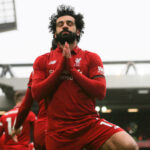
“It’s always good when you see your name with legends of a club like Liverpool. It’s a different feeling, and I’m very happy about that.”
The Reds have secured their second Premier League title under newly appointed manager Arne Slot and a record-equalling twentieth English Top Flight title this season, with Salah being the leading man once again.
Without Mo Salah, it’s hard to imagine Liverpool’s recent triumphs, from Champions League glory to that long-awaited Premier League title.
The contract renewal saga added a layer of uncertainty to his future at Anfield.
Though he signed an extension not long ago, the rumor of a move away from Liverpool lingers, especially with whispers of potential moves to Saudi Arabia or even a switch to Spain in the twilight of his career.
Retirement scenarios, though distant, also seem plausible. A return to Egypt to close out his career, like fellow African legend, Ahmed Musa.
Either way, Salah’s long-term legacy is safe in a crypt.
Whether at Anfield or elsewhere, he will forever be one of the greatest players ever to play the game.
Who wrote this?
Bienuoma Agaga-Akpati is a software engineer, writer, eSports player, and sports enthusiast, presently working with a group of ambitious Africans to transform the writing industry. With good knowledge of various sports and eSports, coupled with his keen ability for research, he loves analyzing ideas and topics that fosters the growth of the sport and eSports scenes. In his spare time, he enjoys creating content and engaging in discussions across various platforms.




